It is not every day we get to see a Philippine basketball team defeat their American counterparts in international soil. Regarded as the greatest basketball nation in the world, the United States is the most difficult hoop country to beat, not just because they invented the sport, but because of the teeming talent that their players have. What more a squad made up of future NBA players, NCAA Division I mainstays and handled by a legendary collegiate coach.
But on the night of July 15, 1985, with an overflow crowd of close to 15,000 fans at the Chung Hua Stadium, the Philippines stamped its class against their American rivals, beating the Golden Eagles selection, 108-100, in overtime, to win their second Jones Cup title.
This week on “Throwback Thursday,” The Rivalry fondly remembers that “glorious moment” (as the late Ronnie Nathanielsz described it) of 38 years ago when the Philippines, represented by the national team and playing under the San Miguel Beer brand, stunned the Eagles to win what is regarded as one of the greatest international victories in basketball ever by a Philippine squad.
Preparation for the ABC
The Hongkong ABC “ambush” stung the country’s basketball officials severely. The 1983 national team was the odds-on-favorites to win the title the country last won in 1973, as the Eduardo Cojuangco-bankrolled squad brought in naturalized players Dennis Still and Jeff Moore. Bracketed in Group D alongside Kuwait and India, the Philippines coasted along with easy wins, 78-57 and 90-60, respectively, to qualify for the four-team championship round, alongside China, South Korea and Japan.
However, in a strange twist, the same ABC officials who gave the nod to the Philippines to suit up Moore and Still in the tournament changed their mind and forfeited the two victories as both players were deemed ineligible. The Philippines was then relegated to the classification round with Kuwait moving to the championship round instead. The Philippines defeated Malaysia, 85-80, and Thailand, 74-69, to end up ninth overall, making them the only team in FIBA-Asia history to win all their on-court games in the tournament and end up ninth.
It was unfortunate because had the Philippines won the championship, they would have represented Asia in the 1984 Los Angeles Olympics. Somehow, China made sure that the odds remained heavily in their favor.
Cojuangco re-channeled his focus on winning the 1985 ABC plum. With Coach Ron Jacobs running the team, some changes were made in the roster, allowing the entry of young Turks like Allan Caidic and Jerry Codiñera of UE, Pido Jarencio and Benjie Gutierrez of UST, Samboy Lim of Letran, Peter Aguilar of Trinity, Naning Valenciano, Yves Dignadice and Tonichi Yturri of La Salle, and UV’s Al Solis, to join regulars Hector Calma, Franz Pumaren, Elmer Reyes, Alfie Almario, Jong Uichico, Jun Tan, plus Still and Moore in the national pool. In 1984, Jacobs also brought in Duke standout Arthur “Chip” Engelland to serve as the third naturalized player.
In 1984, Jacobs kept the team busy by having his national pool of players, donning the Northern Cement Consolidated (NCC) jersey, play in the first two conferences of the PBA. By the end of the year, he brought a roster made up of Still, Moore, Engelland, Calma, Pumaren, Tan, Lim, Reyes, Uichico, Dignadice and Yturri to Ipoh, Malaysia to represent the country in the 2nd Asian Interclub championship. Also participating were the top ballclubs from China (Bayi Rockets), Chinese Taipei (Kuang Hua), Malaysia (PKNS), Bahrain (Al Ahli), Hongkong (South China), Thailand (Bangkok Bank) Kuwait (Qadsia), Singapore (Asia Electric), Macau (G.D. Wa Seng), Sri Lanka (Colombo) and the Brunei national team. The Philippines swept all their rivals, winning by an average margin of 43.5 points, including two demolition jobs against the highly-touted Rockets led by the 7’4 behemoth, Mu Tieh Zhu, 82-62, and 82-56 in the Finals.
In 1985, the PBA adjusted its schedule to help the national team program. They kicked off the season in March with the Open Conference, featuring teams reinforced by imports with unlimited height. The second conference featured the All-Filipino, held in the last week of June. This was also the period when the national team would be busy playing internationally. The third conference, the Reinforced, started in September and ended in the last week of November, or at least 10 days away from the Southeast Asian Games in Bangkok.
Caidic noted the physicality of the pros. “Iba din kasi sa PBA kasi talagang pisikal ang labanan. Lalo na since mga bata pa kami, ranging up against the 11-year veterans, syempre they’ll try to impose their will sa amin. Pero we held our own, kasi we came into each game well-prepared and fully understanding the strengths and weaknesses of our next opponent.”
Immediately after copping third place in the PBA Open, the national team flew to Gerona, Spain for the World Interclub championship. Ranged against the likes of the Yugoslavia Cibona’s Petrovic siblings – Drazen and Aleksander, the De Souza brothers – Marcel and Maury of Monte Libano of Brazil, and future NBA superstars David Robinson, Dell Curry and Chuck Person of the USA Golden Eagles, the nationals, wearing the Northern Cement colors, made a good account of themselves. After suffering a 111-86 defeat against Cibona, they forced the Golden Eagles to a see-saw battle, only to lose out in the end, 81-73. Against Monte Libano of Brazil, Engelland missed a shot he would normally make 90% of the time in the final second as Monte Libano eked out a 78-77 squeaker. In their final game though, the NCC team wiped out the Italian Banco di Roma Virtus squad, 98-79, as Samboy Lim exploded for 37 points.
- Spiking popularity: Comparing volleyball’s following in the Philippines and the US
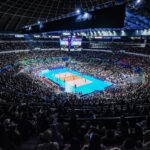
- Cool sweep: How Creamline’s winning formula led to a 7th PVL crown
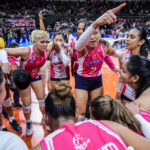
- Pampanga Dragons celebrate 25th anniversary of MBA championship
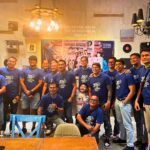
- NBA app launches personalization features, live game experience

- Dante Silverio celebrates 86th birthday in style
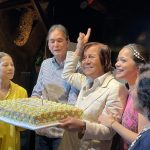
The R. William Jones Cup tournament
The R. William Jones Cup is a basketball tournament held in Taiwan that was named after one of the founders of FIBA. Jones, who was also secretary-general of the FIBA for 44 years, is considered one of the sport’s major pillars. The annual tournament started in 1977, missing out only in 1979.
The Philippines joined the inaugural staging of the Jones Cup, copping 5th place out of 9 teams as they fielded Interclub champion Yanmar Diesel. The USA’s Athletes in Action topped the field with another American team, the Eastern Washington Eagles, ending up second.
The YCO Painters, Yanmar’s rival locally, represented the country in 1978, ending up eighth in a field of 9. Only the tournament for women was held in 1979. In 1980, Sweden won the championship with Kearney State wounding up runners-up. The Philippines, represented by the APCOR Financiers, settled for 10th place.
In 1981, the Philippines participated under the Northern Cement banners with a roster made up of eight naturalized players, two Fil-Americans, and two homegrown talents. The team, also under Jacobs, won its first tournament after sweeping their rivals. Moore and Still were also part of that lineup, alongside Ricardo Brown and Willie Pearson. The naturalized players included Steve Schall, Steve Lingerfelter, Bruce Collins, Mike Antoine, Eddie Joe Chavez and Mike Santos while JB Yango and Frankie Lim were the two homegrowns. Schall, Still and Brown made it to the tournament’s Mythical 10.
Format and opponents
14 teams from different countries in Asia, Europe and the Americas took part. The Philippines was bracketed in Group A with Canada and West Germany. The United States headed Group B with South Korea, Chinese Taipei B and Saudi Arabia completing the bracket. Sweden, Chinese Taipei A, Malaysia and Japan made up Group C while the national team of Uruguay, Italy and Thailand formed Group D.
Prior to the tournament, Caidic admitted he had no idea who they were competing against in the Jones Cup. What he acknowledged though was the US team were the defending champions, having won the 1984 version featuring a lineup led by Karl Malone and top collegiate players who were not able to make it to their 1984 Olympic team. Caidic was part of the 1984 team sponsored by Countryfair Hotdogs and mentored by Larry Albano.
But Jacobs had a different take. Comparing their stint in Spain, the mercurial coach described it succinctly as “we went to Spain for the experience and the exposure, we went to Taiwan to win.” When asked what was the turning point of the Jones Cup sojourn when he felt they could win it all, Jacobs replied, “in Gerona!”
The Americans made sure they were ably represented in their quest to win their sixth Jones Cup championship and furth in a row. No less than the legendary Gene Keady, head coach of Purdue University, handled the team made up of future NBA players Harold Pressley of Villanova, Kevin Henderson of Cal-State Fullerton, Kenny Gattison of Old Dominion, and Joe Wolf of North Carolina. Other members of that star-studded team included Keady’s boys at Purdue – Troy Lewis and Todd Mitchell, Duke’s Tommy Amaker and Jay Bilas, San Diego State’s Anthony Watson, Auburn’s Frank Ford, Texas’s John Brownlee, and Carven Holcombe of Texan Christian.
Game time
The format had the top two teams per bracket making it to the championship round. The Philippines defeated Jack Donohue-coached Canada, led by no less than the veteran Jay Triano and a young seven-foot Greek-Canadian, George Papadakos of Syracuse and Michigan State, 69-58, then walloped West Germany, 82-61. The United States and South Korea topped Group B, Group C’s Sweden and Chinese Taipei A advanced to the next round while Group D had Uruguay and Italy, featuring NBA 3rd round pick, Stan Mayhew of Weber State, advancing.
In the championship round, the eight teams were to face one another with the team with the best record ending up as champions. By virtue of topping Group A, the Philippines toted a 1-0 card when they beat Canada in the qualifiers. They then flexed their muscle by creaming the Jim McGregor-mentored Italians, 96-75, demolishing the Lee Chung Hee-led South Korean national team by double digits, slaying the hosts, 80-66 after limiting US-born Taiwanese Richard Chang to only four points, upending the bigger and taller Swedish roster led by naturalized player Billy Magarity of University of Georgia, 73-66, then beating a tough Uruguay team, 64-57, for a 6-0 card. Quite interestingly, the nucleus of the Uruguay team played in the previous year’s Los Angeles Olympics where it finished sixth overall. Their two top players who suited up in the Jones Cup were Horacio Lopez and Wilfredo Bruno Ruiz. Lopez also scored the tournament’s single game-high with 47 points. They were backstopped by key players Juan Mignone, Luis Larrosa, Herbert Nuñez, and Luis Pierri – all of whom stood 6’7 and above. The team was coached by Ramon Etchamendi.
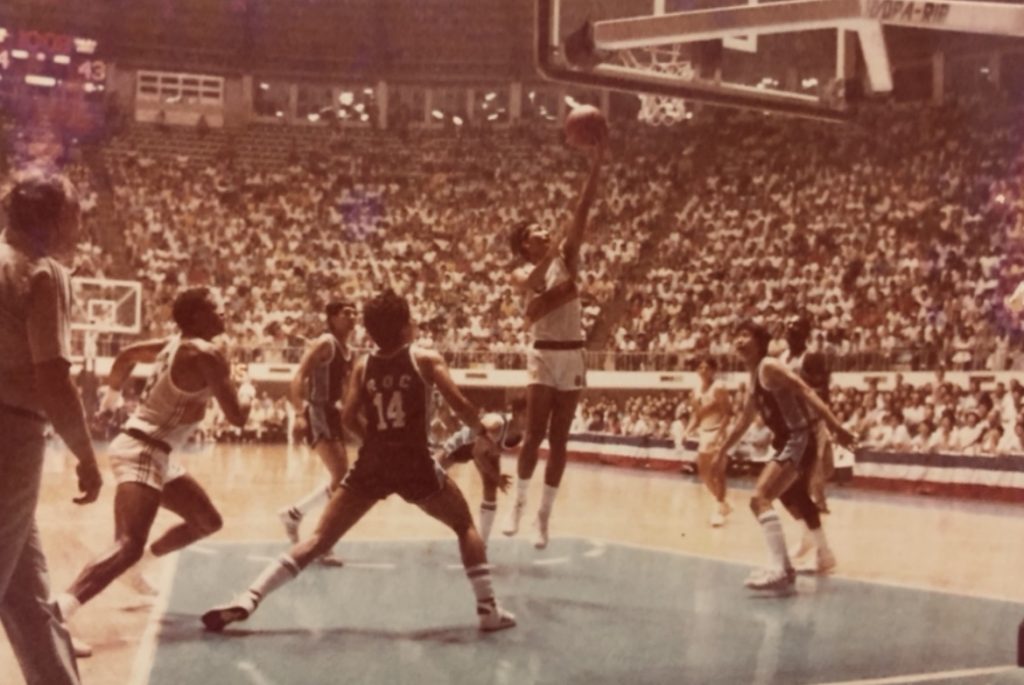
Caidic described the Uruguay game as one of their difficult matchups. He recalled how Uruguay played physical against them, as Moore struggled to essay his do-it-all game against the taller bruisers from South America. But it was also the game that Caidic described as his best in the tournament, leading the Philippines in scoring as he burned the hoops from beyond 22 feet. “Yun depensa, nakatutok sa loob kaya I got the license from Coach Ron to shoot from outside. When I got my first shot in, my confidence went up and was able to sustain this for the whole game,” Caidic explained.
San Miguel was up 60-57, with 44 seconds left when Lopez fouled Engelland in the ensuing play. Jacobs, who normally instructed his players to waive their free throws when they get fouled, instead told Engelland to take the charities. He made both, and then was fouled in the next play by Pierri, to complete the count. “I wanted to show to Chip how much confidence I had in him when taking the free throws.” Curiously, in their game against Chinese-Taipei A, Engelland struggled badly in the game, netting only two points on 0 for 5 in the 3-point region and 1 for 6 in the 2-point area.
Caidic validated this by saying Jacobs employed the “waive the free throws” policy because it possesses more advantages. “If I miss the first free throw on a one-and-one, that means the opposing team has a better advantage of gaining the rebound after the miss. But if you waive the charities and inbound the ball instead, you get a full 30-second shot clock to waste,” Caidic rationalized. “So if we’re ahead in the closing seconds of the game and the trailing team resorts to giving out fouls, we won’t be surprised if we opt to waive.”
It was also in the Uruguay game when Still suffered an ankle injury. This became a major source of concern, because the injury might have an adverse effect on him in the ABC. Caidic admitted that while “winning the Jones Cup was something they wanted to accomplish, the bigger goal was the ABC tournament.”
With a swollen right ankle, Still limped gingerly. He was a game time decision as the team physician worked overtime to manage the pain. Eventually, Still, who ended up as the tournament’s best rebounder with 11 a game, decided to suit up for the USA game. Incidentally, the Americans did their part by sweeping the rest of their rivals to get to 6-0, tied with the Filipinos entering the last day.
“Dennis is so valuable to the team because he takes up so much space inside and is a phenomenal defender,” Caidic said. “He’s a voracious rebounder and, pain or no pain, will give you the same effort.” Jacobs added, “one thing I can guarantee, when Still plays, he gives 100% of himself.”
Then, there was Moore. Jacobs admitted that Moore was also not healthy in the USA game. “Jeff had the flu and a persistent cough that wouldn’t go away when we faced the Americans. But Jeff has so much heart as he has talent. In our game against Sweden, I assigned him to Magarity, who was at least four inches taller than him. But he still gave Magarity a difficult time, especially on the defensive end.” Magarity tallied 26 points in a losing cause while Moore approximated his feat, chipping in 23 of his own.
“Jeff is our do-it-all player. He scores, he rebounds, he defends, he passes to the open man,” said Caidic. Despite being undersized at 6’3, Moore’s athleticism and upper body strength allow him to compete against the best big men around the world. “Sobrang sipag, tapos mabait pa,” Caidic described.
The championship game
It all boiled down to one final game for all the marbles. Both the US and Philippine teams had 6-0 cards, and it was quite a coincidence that the tournament organizers scheduled the last game of the tournament featuring the top two teams. While the Americans were the prohibitive favorites, the Philippine team was no slouch, especially after their World Interclub stint in Gerona. Caidic felt that despite the grueling effort they went through in Spain, going up against opponents almost twice their size, they knew they were special. “Isipin mo, kalaban namin, mga Amerikano, mga Yugoslavs, mga Brazilians at Italians, and we actually competed well against them? Nakasabay kami sa kanila, kahit papaano. Sino ba naman ang hindi tataas ang kumpiyansa nun?” Jacobs stated almost the same thing after the Gerona stint.
Jacobs started with Still, Moore, Engelland, Lim and Calma. Keady countered with Ford, Wolf, Gattison, Pressley, and Amaker. The Americans drew first blood when Pressley scored a medium range jumper that was quickly negated a 19-foot jumper from Engelland. After a miss, Calma made a transition layup, getting a foul to boot from Amaker to give the nationals a 5-2 lead. A midrange jumper and a trey gave the Philippines a 10-4 lead early in the game.
The Americans, using their height, heft and power inside, reversed the tide after exploding for a 13-3 run to give them a 17-13 lead with 12:46 left in the first half. The game was see-saw from there but in the 5:37 mark, Calma picked up his third foul off Amaker, forcing Jacobs to make a major adjustment. With reliever Pumaren nursing two fouls as well, he brought in Lim to replace Calma, giving point guard duties to Engelland with Lim and Caidic at the wings.
After an Engelland trey to bring the lead down to 2, 32-30, Lim jumped off the roof to swat away Gattison’s low post shot to the collective cheers of the crowd. A drive by Lim off a feed from Caidic knotted the count at 32-all. A 6-0 blast gave the Eagles a 38-32 lead with less than two minutes left but a jumper from Caidic and a difficult pump shot off the 6’10 Wolf kept the nationals in the game, 1:16 left in the first half. A Caidic free throw and a follow-up tap from Lim gave the Philippines a 40-38 lead before Wolf tied the count at 40 at the end of the half.
The Americans exploited a couple of errors from the Philippines to build a 46-40 lead early in the second half before Lim sank three straight treys sandwiching a Pressley jumper and an Amaker layup to keep in step, 50-49. Another trey, this time by Engelland after a Gattison split from the line, tied the count once more at 52.
It was nip and tuck from there as both teams took turns with the lead. But Caidic sank a trey then drew a foul off a converted basket from under to give the Philippines a 65-61 lead. But in the next play, Calma was called for his fourth foul. A layup from Henderson cut the lead to two, but Engelland made a top of the key three-point basket to give the Philippines a 5-point lead, 68-63.
Just when fortunes seemed to favor the Philippine side, Still was assessed his fourth foul, forcing Jacobs to relieve him with Yturri. With 3 key players – Moore, Still and Calma in foul trouble, danger loomed.
Caidic made another basket to give the Philippines its biggest lead, 70-63. But with 7:20 left, the Triggerman got caught with his fourth foul. Up by 6, it was Pumaren’s turn to burn the Eagles with a trey from right elbow, 75-66. Back-to-back baskets by Lim and Engelland gave the Philippines a 79-72 lead with less than 5 minutes left. But back-to-back passing miscues by Still plus a turnover from Engelland gave the Americans five points in transition, 79-77 with 3:03 left.
With 53 seconds left, Calma picked up his fifth and final foul against Gattison. The Old Dominion mainstay coolly sank both free throws, tying the game at 83. Engelland was fouled by Wolf beyond the arc, and the future shooting coach made all three shots to give the Philippines an 86-83 lead with 38 seconds left. A Gattison dunk cut the lead to 1, but Pumaren was called for double dribble in the next play. A hi-lo play allowed Amaker to feed Gattison inside unmolested as the Eagles regained the upperhand, 87-86 with 11 seconds left. Moore then attacked the paint and Amaker was called for his fifth foul after trying to swipe the ball away from Moore’s hands. Moore’s first free throw made a lucky shooter’s bounce to tie the game at 87, but missed the second, sending the game into overtime.
Extra time needed
It was the first time the Philippines won the jump ball in this game and it came at a perfect time. A feed from Pumaren gave Engelland the space he needed for a booming trey, 90-87 to kick off the extension. With the Filipinos’ defense working, the Americans were forced to take a hurried attempt with the shot clock winding down. In the next play, Moore sank a layup plus a foul to stretch the lead further to six after converting the and one, 93—87.
An exchange of baskets after, Moore was then called for his last foul against Gattison. He split his free throws, made another pair in the next play, then Engelland hit seven straight points, including an off-balanced trey that found nothing but net, to give San Miguel an imposing 100-90 lead with the shot clock winding down at the 2:21 mark. Missed three-point shots from the Americans, plus two layups by Lim and clutch free throws from Pumaren closed the game at 108-100, giving Jacobs and the Philippines their second Jones Cup title.
Engelland exploded for 43 points, including eight triples. Lim added 23, Caidic struck for 19 points while Moore ended up with 13 points. Pumaren and Calma rounded up the score sheet with 7 and 3 points, respectively. Gattison was the Eagles’ top scorer with 28 points.
Cap off
Jacobs was quick to dismiss the monumental feat of winning the Jones Cup, much less, beating Keady at the sideline. He admitted that “they were lucky” even if the game-changer was the Filipinos’ 15 three-point shots converted against their opponent’s one. “The 3-point shot is a great equalizer, it adds a whole new offensive dimension to keep a shorter team competitive in a game where height makes a big difference,” Jacobs revealed.
Another factor was the scouting. Caidic mentioned that half of the game was won during the actual preparation when the scouting reports gave them an opportunity on how to deal against their bigger rivals. One discovery was that Pressley couldn’t post up, preferring to shoot while facing the basket. The starter for the 1985 NCAA champion team Villanova, Pressley found himself going up against Lim, who was at least six inches shorter. Yet, Jacobs was able to afford making this defensive risk since Pressley didn’t post up underneath.
Wolf was also slow-footed, allowing Jacobs to exploit Moore’s athleticism to snare the offensive rebounds even if he was seven inches shorter. Jacobs also discovered that Keady relied heavily on his bigs, particularly Gattison, to score points inside the lane while not opting for his players to shoot from afar. This allowed Jacobs to utilize the 2-3 zone more effectively given the absence of reliable outside shooters from the opponent.
Keady described Lim and Caidic as “clones,” except that one was left-handed. It was a gesture of admiration from the legendary coach who could only shake his head after every triple made by the pair that not only kept the Philippines in the game, but also gave them extra cushion in the crucial minutes.
Jacobs summed up everything after MBS Channel 4 replayed the game with him and Nathanielsz covering. In that coverage, Jacobs practically taught a module on coaching during actual situations and making decisions on the fly. It was their desire to win the game that led to the victory, he said. “We played to win while the Americans played not to lose,” Jacobs stressed.
